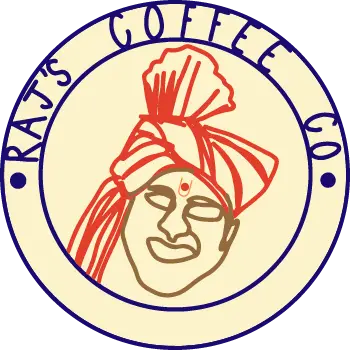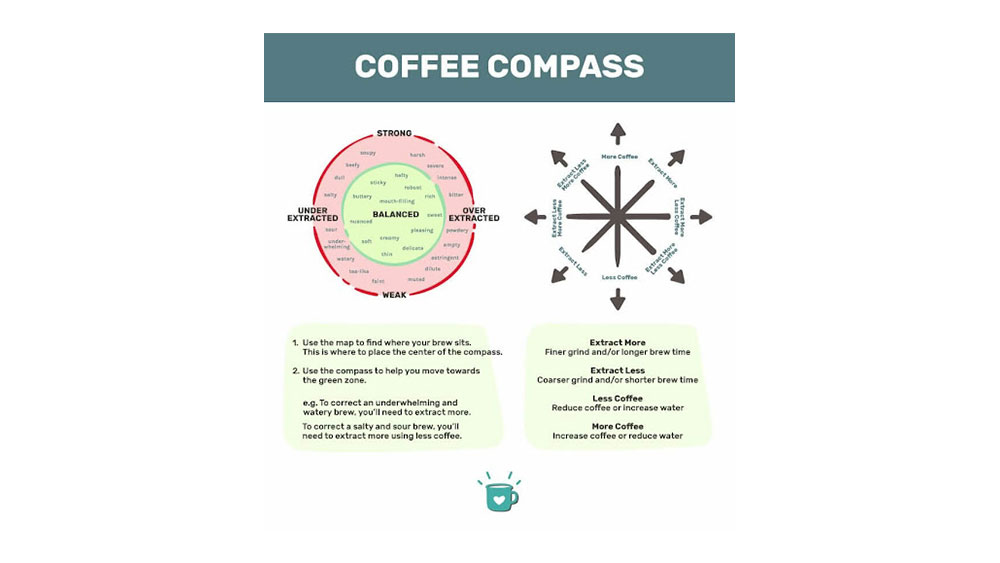When brewing coffee in your home, there can be a range of different problems that you encounter with your brews. These can range from the water from your kettle being too hot to the coffee that you’re working with simply being a little stale. Well, there is actually a fascinating too that can help you to explore the best ways to correct brews from your home bar that are perhaps a little under the weather – the coffee compass is here to help your brewing!

At the most basic level, the coffee compass is a simple thing. It consists of a rough diagram of coffee flavors and a directional graph of solutions. The idea is simple, you find a word on the diagram to describe your brew (sour, for example) and note which direction you need to travel in to achieve a better flavor.
For a sour coffee, you need to transport your brew right on the coffee compass. The directional graph gives you a solution for this – extract more flavor from less coffee. There are a number of ways to do this, and that’s what we’re going to be talking about today.
Too strong
A brew of coffee that’s too strong might sound like something a little hard to make happen. Well, that’s actually not the case – many brews can be a little too strong for their own good, and can often taste sharp and strong. Brews that are too strong can also taste a little soupy, since the texture of the coffee may have some small pieces floating in it, altering the mouthfeel.
A brew that’s too strong is at the exact top of the coffee compass. Therefore, we can use the coffee directional graph to see that we should use less coffee in our brews.
This is a simplistic way of looking at it – what the graph means is that you should correct your ratio of coffee to water. For a liter of water, James Hoffman typically recommends starting at 60g of ground coffee. With a little math, you can figure out the weight of coffee needed for your brew. If the taste is still too strong, reducing it to a 50g per liter ratio could be a good first step.
Too weak
Coffee being too weak is truly infuriating. We’re certainly not speaking only for ourselves when we say that the reason a morning cup of coffee is so great is that it feels like it grabs you by the shirt and wakes you up in the mornings. Well, if you don’t achieve that brew, then your coffee is, perhaps, a little too weak.
A weak brew will typically taste a little like tea, in that you’ll likely be able to taste the notes of the tap water within the coffee that you’re drinking.
Going by the directional coffee compass, we know what the next step is from the base of the coffee wheel – more coffee will take us vertically upwards.
More coffee is, of course, the inverse of what we were just talking about. If you were to start at the 60g per liter ratio that we mentioned before, more coffee could be bumping it up to 65g or 70g per liter of water in your brew. This will lead to a much more intense coffee flavor since there’s simply more coffee in the brew.
Under extracted
It’s quite hard to tell, from a beginner’s point of view, if a cup of coffee is under-extracted. The best way to tell that, and give it a little bit of consideration, is to question whether the primary flavors in your cup are quite sour or salty. These flavors are some easily soluble compounds in all different food and drink, meaning that an under-extracted brew has had a chance to dissolve those first compounds, without getting its hands on those more elusive coffee flavor compounds.
Using the coffee compass, we can see that we need to travel to the right, which means more extraction is required, and less coffee, perhaps, ought to be used.
More extraction is quite easy to achieve really when you consider that the process of extraction is mostly just the dissolving of flavor and aroma compounds from the coffee grounds themselves. To make the compounds more easily available, you can grind finer. Alternatively, you can draw out the compounds over a longer period of time by simply allowing the coffee to be immersed in hot water for longer. This will draw the flavor out easily.
When you do increase the level of extraction that you’re working with in your coffee, it can become overwhelming quite quickly. The reason for this is that you’ll have greater extraction over the same volume of coffee, leading to a more intense flavor being extracted over the same period of time. In the end, you can have quite a potent brew.
To counter this problem before you really encounter it, it’s worth decreasing the coffee dosage by a gram or so. You may still run into the same problem, but it will be easier to account for over time, which makes the entire process a lot simpler.
Over extracted
If your coffee is over-extracted, you might consider it to be bitter or powdery. When we say that a cup of coffee is bitter, you might say ‘yes, obviously!’, and you’d be right to do so. Coffee is naturally quite a bitter drink, but when coffee is over-extracted, the bitterness can become so intense that it becomes hard to drink.
To cut that bitterness, we need to use the coffee compass to travel left, meaning that we should extract less flavor from a little more coffee.
The simplest way to do this is to make our coffee a little more coarsely ground, as that will result in less extraction possible over the course of a given period of time. This will cut the bitterness and, hopefully, allow you to enjoy a rich brew with a robust flavor that, while it’s not weak, is certainly not strong and intense.
Conclusion
Brewing coffee can be tricky, and the coffee compass is a great way to consider how you can easily change things up in your home brewing routine. We hope that it’s been able to give you new insight into brewing better and better cups in your home.

